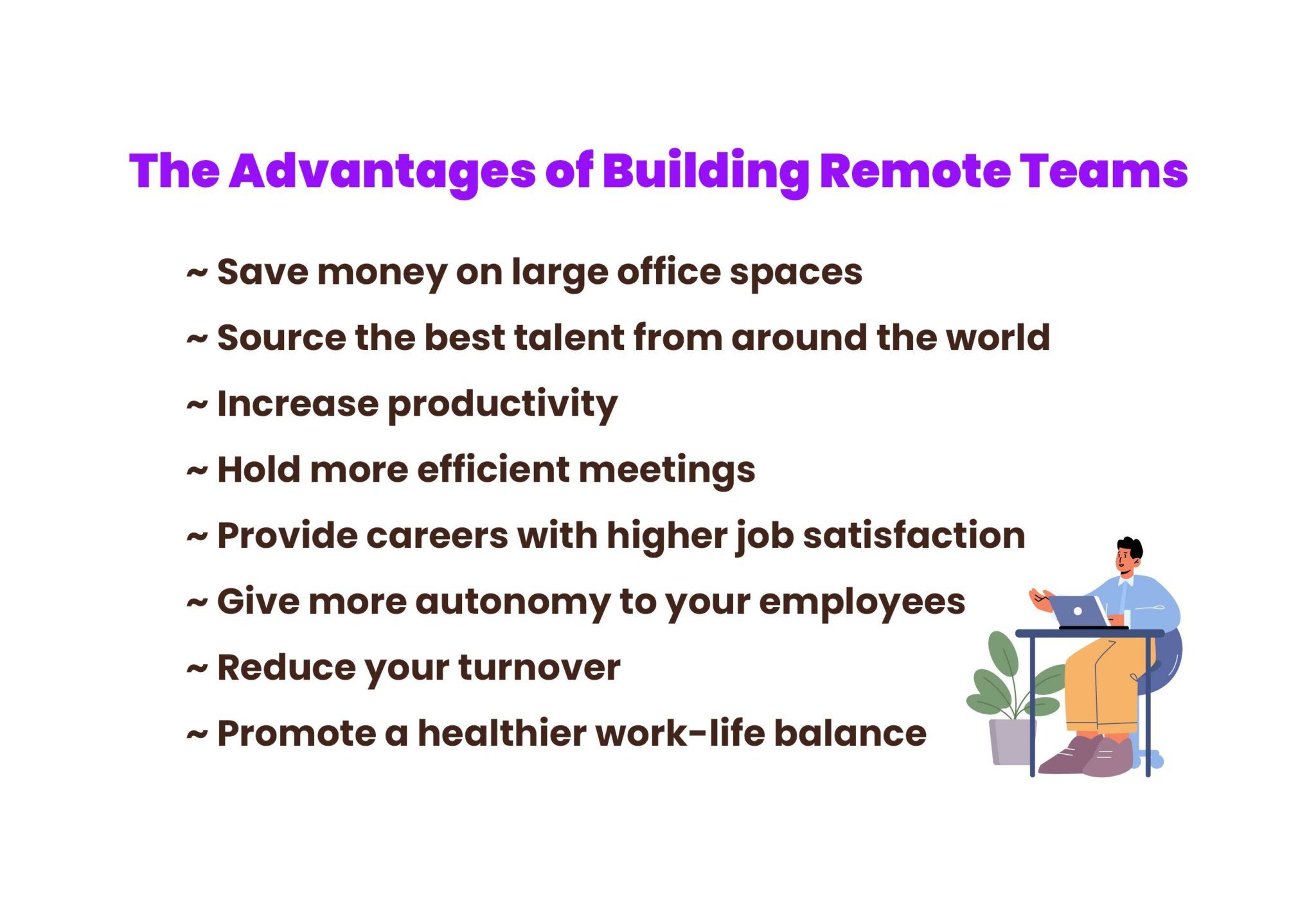Understanding how to scale a remote team is essential if you’re thinking of setting up your own IT consulting firm. In recent years, the need for company executives to manage remote teams has grown tremendously due to the attractiveness of a remote workforce. The advantages of remote working are many. And they may be reaped by both the business and the remote team members. These benefits include increased employee satisfaction due to the flexibility of working places and a more extensive global reach for the organization.
Why choose remote teams?
When discussing how to scale a remote team, it is essential to consider why they have chosen to work remotely. Consider the following scenario: you want to launch a new IT firm in a few months. It’s been proven that companies can save a lot of money on employee costs with remote teams. And this is because they don’t need to have physical office space. This means that the business usually doesn’t have to spend a lot of money at the start.
In recent years, remote working has become more popular among IT professionals and small and startup organizations. And the global pandemic has significantly contributed to this increased popularity. The settings in which these organizations operate are constantly changing. Therefore, they see the obvious advantages of not making a significant investment in a physical work location.
Remote working has many advantages. But it also poses many obstacles to businesses and the people in charge of management inside the organization. Managing a remote workforce comes with several issues. These may include ensuring that employees are working as efficiently as possible, that they are present when they are needed, and that they are motivated.

What Exactly Does It Mean to Scale a Team?
Scaling a team is simply the process of increasing revenue while keeping team costs at a constant level. If your sales rise by 40%, but you have to add five additional workers to your team, you aren’t scaling it. If you can handle that 40 percent growth with your existing personnel, you have successfully scaled your company’s operations.
How to scale a remote team: step-by-step instructions
UC Berkeley and Stanford researchers found that 70% of the companies they studied sought to scale too early before other basics of their company were in place. They published their findings in the Startup Genome Report. A key conclusion of the analysis was that premature scaling was a contributing factor in 90 percent of failing startups. Therefore, as well as knowing how to scale remote teams, you must know the right time to go for it.
What is the source of this widespread issue? It all boils down to the reality that none of these choices are made in a vacuum. For some startups, the temptation to exploit hiring statistics as a façade of success while under pressure to enhance performance may be tremendous. A startup founder could be under a lot of pressure to show investors that things are going well for the next meeting. On the other hand, a mid-sized (proprietary) software company would have to respond to many requests for a new feature and make it happen before their competitors.
The time it takes to see a return on investment (ROI) varies by position (the position in the management hierarchy of the organization) and might be months long. Among the costs of recruiting are the time spent by existing workers teaching new employees and the cost of hiring itself. It costs the company a lot of money and time to get rid of people who aren’t healthy or who leave early. Don’t focus on a short-term victory to distract from long-term uncertainty. Invest time in defining how your organization’s mission, values, and culture will be implemented on a new team.
Below are the crucial elements of how to scale remote teams:
Continue to be adaptable (stay agile)
When referring to a group, the word “agile” describes their capacity to adapt. The self-organization of all team members is the first step in scaling your remote team. The completion of any product or project relies on various people, including developers, designers, QA officers, and so on. Teams that work in an agile manner are cross-functional and have a shared sense of responsibility for the outcome.

Scaling your business the old-fashioned way will result in organizational silos and sluggishness. On the other hand, firms that use an agile approach find it much simpler to adapt to scalability problems. When business experts first used agile methods, they thought they could only be useful for small-scale projects. Perceptions, on the other hand, have shifted dramatically.
An agile team is defined as a team that executes an agile project (a project that follows iterative development which results in continuous and incremental improvement.) For example, by establishing the significance of features, the team may understand the most critical aspects of a project that might provide value. When a team of software developers uses an agile methodology, they may meet a project’s deadlines and costs progressively, allowing it to be launched sooner and begin earning revenue sooner.
Diverse firm personnel may come together to provide the first scope of work, i.e., the MVP (Minimum Viable Product), much more quickly than anticipated if they work cooperatively on the project.
Create a highly effective, distributed development team
When wondering “how to scale a remote team,” this is one of the most crucial things to keep in mind as you plan. Your firm will never be able to expand effectively if you recruit the wrong individuals for the job. For agile teams to work, team members must work together to accomplish tasks. The task of identifying the most qualified candidates in this industry is challenging. But one must also keep in mind that there’s intense rivalry among firms. Therefore, it has become challenging to provide above-average pay and perks to their employees.
A distributed team provides the ability to enrich your current resources with specialists and generalists. It also gives you access to a larger global talent pool with more favorable wage expectations. And this improves your return on investment and increases your productivity.
The problem is that leading a remote team may be very difficult to manage. In your capacity as a company, you will be responsible for supplying your remote workers with the required infrastructure and technology. While some organizations choose to hire in-house staff or freelancers, the majority prefer to use an alternative method known as outsourcing.
Using an outsourced development team is a good idea
It takes a lot of time, money, and dedication to hire a new employee. If you hire someone, you have to provide them with perks like health insurance and an annual bonus, among other things. The same situation applies if you employ a freelancer. You should not expect them to devote their complete attention to your project alone. And this is because they may be working on many other projects at the same time as your project. Outsourcing is an excellent middle ground since it allows you to save time and money while still receiving total devotion. The option of outsourcing tasks that are excessively time-consuming and create undue pressure on your present employees is available to you as well.

Moreover, outsourcing is a great way to build a distributed team because you don’t have the skills in-house or you have too many projects. There are several advantages to outsourcing, including the fact that there are no set costs; you will only be charged for the services you get for a particular project. In addition, outsourcing lets you quickly grow and slim down your development team with varying needs. You don’t have to worry about letting people go when the project is done or hiring quickly when the project is growing.
Choose the Most Appropriate Processes and Technology
This is another prime element to consider when discussing the topic of “how to scale remote teams.” Open communication is key to managing a remote group of people. And if you employ an agile strategy, it is critical to maintain open communication and utilize the right technologies in development. And these may include video conferencing, project management, etc. It’s essential that you automate all the automatable jobs. An automated task management system will allow the teams to focus on high-impact work instead of tedious duties.
If outsourced, you should ensure that your outsourcing contractor provides all of the tools and resources necessary for the various developers to perform their duties. Ensure that your in-house staff are in sync with your outsourced staff and have access to all the resources they need to execute their jobs.
It becomes more challenging to determine which technology is the best choice and when to invest in it as time passes. Leasing technology gear and tools is an excellent alternative to buying them, as it avoids the entire cost of the item. If you choose this route, you won’t have to stress about finding the money to buy the tools you need to get started right away. You only have to pay a monthly fee for each user and per device.
It’s essential to connect your scaling strategy with your current company demands while also planning for future expansion for scaling your remote team. If your business adapts quickly, it will be easier for your development team to keep up with changes.
Analyze and make modifications as necessary
To be successful in any undertaking, you must be open to the possibility of change. For a company to be successful, it must constantly monitor changes in the market and adapt its strategy accordingly. Develop and promote best practices for your whole team, no matter how geographically scattered they may be. To become more adaptive, your company will need to take a proactive approach to monitor the changes.
Taking a proactive approach also helps identify relationships amongst teams, as well as the identification and mitigation of possible hazards. In the case of environments that have utilized Scrum, adapting Scrum ceremonies to the demands of each team is essential. You must also pick the most appropriate strategy for the team’s size. Retrospectives provide an excellent chance to evaluate your company’s return on investment, efficacy, and productivity.
Treinetic’s final words on how to scale a remote team
Scaling a remote development team may be difficult. But the advice provided above on how to do it will help managers and team leaders build a solid foundation for future growth and expansion.
When implementing agile techniques and putting technology and procedures into place, it is critical to identify cooperation among individuals and the dependencies between them. Assemble the right team, whether inside the company or externally contracted. Only then can you ensure that best practices and solid relationships are in place to provide a mutual understanding of the desired outcome.

